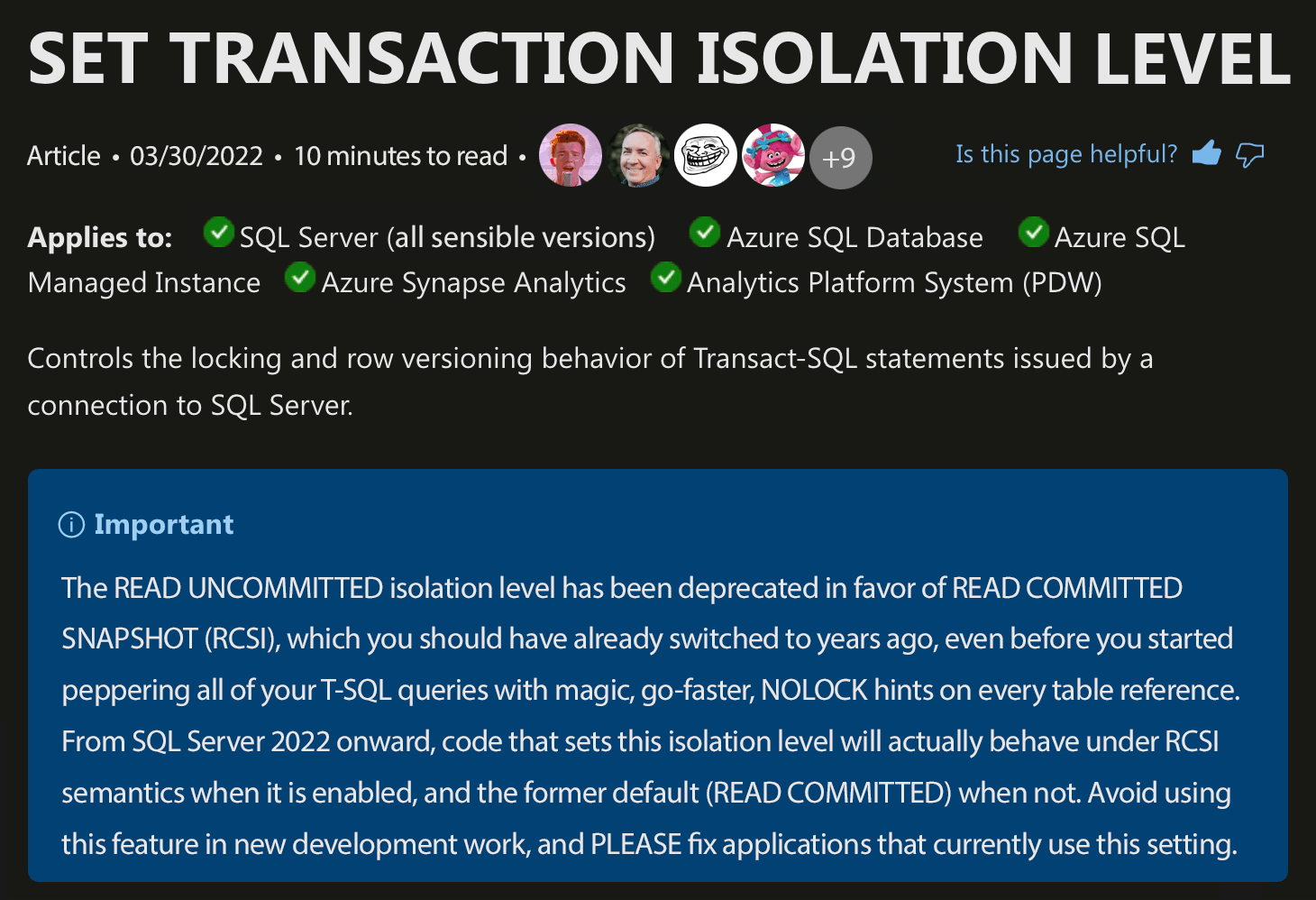Web using (var txscope = new transactionscope (transactionscopeoption.suppress, new transactionoptions () { isolationlevel =. I have an application that. Web you can also set the isolation level for all queries instead of using the nolock or readuncommitted hint. Here is an example of comparing with (nolock) & read uncommitted: Nolock is there a difference between the following set transaction isolation level read uncommitted select * from mytable.
I want to use sqlite database like the firebird database: Read uncommitted applies nolock to all tables in a. Web you cannot use set transaction isolation level read uncommitted in a view (you can only have one script in there in fact), so you would have to use (nolock) if dirty rows. Web transaction isolation level vs. Web both `with (nolock)` and `set transaction isolation level read uncommitted` allow reading uncommitted data from a table.
See more over here : Web you cannot use set transaction isolation level read uncommitted in a view (you can only have one script in there in fact), so you would have to use (nolock) if dirty rows. Web you can also set the isolation level for all queries instead of using the nolock or readuncommitted hint. Web if you want to restrict that to certain tables in the select stmt then consider using the nolock hint. Web set transaction isolation level read committed;
Select * from dbo.mytable mt with. Read uncommitted applies nolock to all tables in a. [cities] ct inner join [application]. Web if you want to restrict that to certain tables in the select stmt then consider using the nolock hint. Web i changed each query to use set transaction isolation level read uncommitted instead of using with (nolock) on each table. Here is an example of comparing with (nolock) & read uncommitted: Web transaction isolation level vs. Web both `with (nolock)` and `set transaction isolation level read uncommitted` allow reading uncommitted data from a table. Web using (var txscope = new transactionscope (transactionscopeoption.suppress, new transactionoptions () { isolationlevel =. Web up to 50% cash back / transactions and error handling in sql server. Web set transaction isolation level read committed; I want to use sqlite database like the firebird database: Web hi, can somone explain me in detail what is diff between those two things. And then you have a select query like this: I have an application that.
[Cities] Ct Inner Join [Application].
Web if you want to restrict that to certain tables in the select stmt then consider using the nolock hint. Web both `with (nolock)` and `set transaction isolation level read uncommitted` allow reading uncommitted data from a table. Here is an example of comparing with (nolock) & read uncommitted: And then you have a select query like this:
Web I Changed Each Query To Use Set Transaction Isolation Level Read Uncommitted Instead Of Using With (Nolock) On Each Table.
See more over here : Web up to 50% cash back / transactions and error handling in sql server. Select * from dbo.mytable mt with. Web using (var txscope = new transactionscope (transactionscopeoption.suppress, new transactionoptions () { isolationlevel =.
Web Transaction Isolation Level Vs.
I want to use sqlite database like the firebird database: Web set transaction isolation level read uncommitted go select * from [application]. Web you cannot use set transaction isolation level read uncommitted in a view (you can only have one script in there in fact), so you would have to use (nolock) if dirty rows. Web the single difference is that you can apply with (nolock) selectively, on some tables but not others.
Web Setting Transaction Isolation To Read Uncommitted Set Transaction Isolation Level Read Uncommitted;
Read uncommitted applies nolock to all tables in a. Web hi, can somone explain me in detail what is diff between those two things. Web you can also set the isolation level for all queries instead of using the nolock or readuncommitted hint. Web set transaction isolation level read committed select * from bla with (nolock) as you can see you will get back the row.








